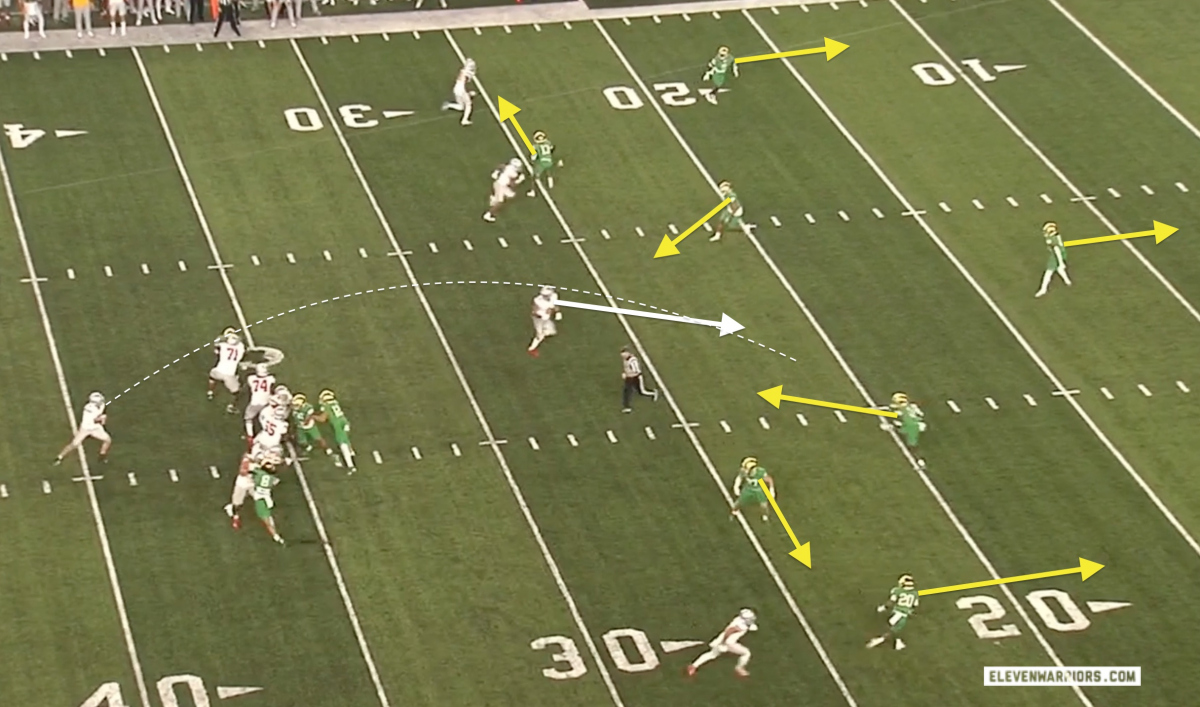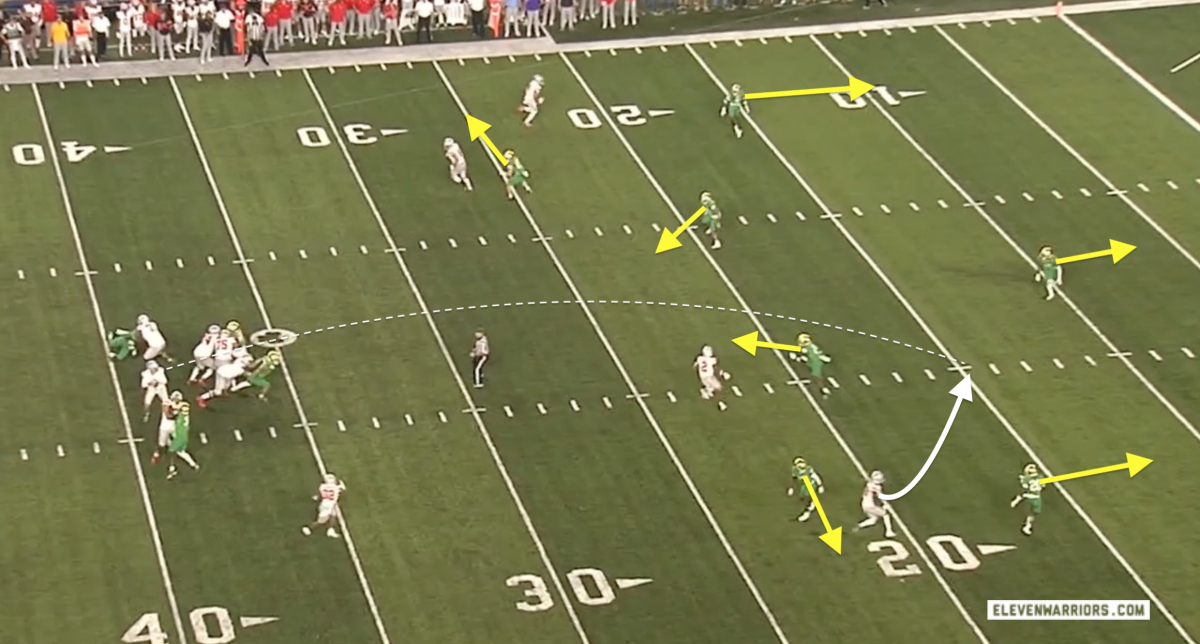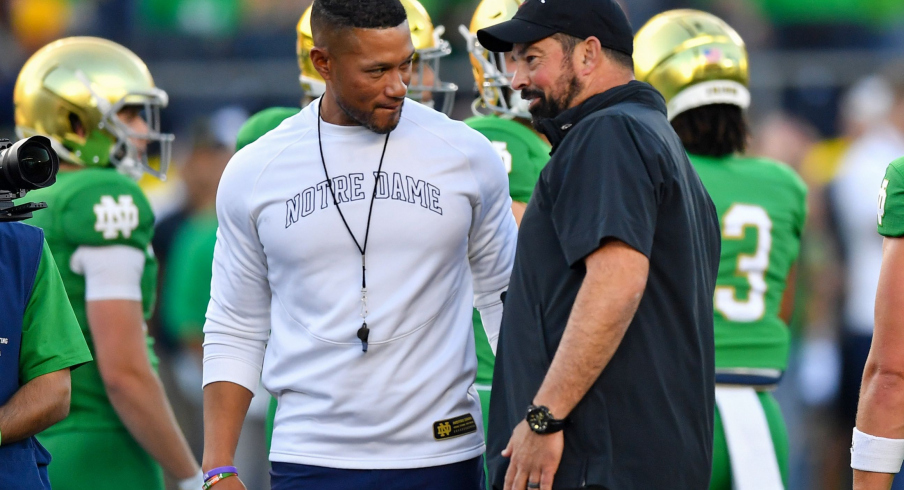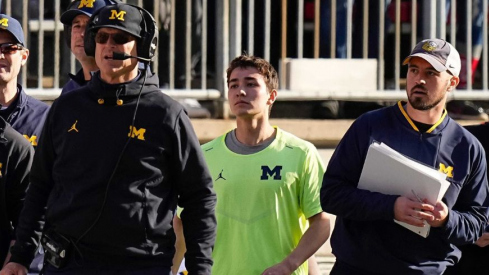4th & 1. 10 men on the field. Lou Holtz's whereabouts.
There are plenty of reasons to question the decision-making of both Ryan Day and Marcus Freeman following last Saturday's barn-burner in South Bend. But to pretend as though they and their staffs hadn't engaged in a high-level chess match prior to a series of blunders questionable choices in the game's waning moments is naive at best and downright disingenuous at worst.
The second matchup in the home-and-home series was a very different game than the one that took place a year earlier inside Ohio Stadium. This time, in the shadow of Touchdown Jesus, both teams seemed intent on imposing their will at the line of scrimmage without giving up an explosive play downfield.
Despite a low score with just 31 combined points, it was still a remarkably well-played game, as both teams averaged over 5.5 yards per play offensively, failed to turn the ball over, and combined for just 9 total penalties and one sack allowed. Though they went a surprising 0-4 in 4th & 1 situations, they were 15-27 (55.5%) on third down, significantly higher than the national average (41%).
While both teams should feel good about the way they played that night overall, there are certainly some areas in which they'll wish they'd been better.
For Ohio State, the run defense, in particular, stands out as an area in which it seemed to lose more battles than it won. The Irish averaged 4.5 yards per carry, a far cry from the 2.52 average the Buckeyes allowed going into the game.
While Jim Knowles' unit looked prepared to stop one-back runs, they seemed to struggle when facing two-back looks. As the game progressed, the Irish continually lined up a running back on either side of Sam Hartman in the shotgun, with one acting as a lead blocker for the other.
This lead block created an extra gap to be filled right in the middle of the Notre Dame offensive line. But with OSU sitting in 4-2-5 personnel for most of the night, the defender tasked with providing extra coverage for this new gap was often a safety who regularly got lost in the wash of blockers and was unable to fill his gap after lining up 10 yards deep.
Down 10-0 midway through the third quarter, the Irish doubled down on these two-back runs, relying on them for a significant chunk of their 75 and 96-yard scoring drives late in the game.
Not only did they lean on these two back sets, but the Irish incorporated unbalanced formations more and more as the game wore on. All-American left tackle Joe Alt (#76) would flip spots with the tight end and line up outside the right tackle, giving the home team a massive surface to run behind on that side.
When they added a lead-blocking fullback and a pulling guard for an old-school Power play, the Buckeyes had few methods of slowing down the Irish ground game.
When Notre Dame took the ball with just over four minutes to play, it certainly seemed like they'd ice the game after two consecutive first downs on the drive's first two plays, the second of which was yet another two-back run. But after Hartman took the third snap of the drive, he seemed to forget which side the play was going, missing the handoff and allowing JT Tuimoloau to bring him down for a five-yard loss.
That play proved to be a turning point, as the Irish would punt three plays later and allow the Buckeyes to ultimately win the game. The visitors were fortunate to be the beneficiaries of such a mistake, as there was little reason to believe that they would miraculously find a way to slow down those two-back runs.
But for those ready to scream at Knowles right about now, it's worth recognizing why his safeties were so slow to fill the extra run gap such runs created.
All game long, the Buckeyes eschewed their typical reliance on tight, man-coverage for conservative zone schemes. Hartman may be the best deep-ball passer the Buckeye defense will see all season, and Knowles seemed determined to make his opponent put together long drives instead of giving up the explosive plays that haunted his team last season.
With nowhere to go downfield, Notre Dame consistently attacked the space around Ohio State's inside linebackers, flooding their zones with more bodies than could be covered. Wadsworth native Mitchell Evans set career highs for both receptions and yards that night from his tight end position, constantly finding space behind the stretched OSU 'backers.
With these deep zone coverages in place, the Buckeyes didn't surrender a gain longer than 28 yards all night long. The most explosive Irish passing plays came via means other than chucking it downfield.
Coming into the game, Ohio State defenders had to know their opponents liked to run plays with two different screen concepts at once, giving Hartman the option of throwing to either side. But when the Irish called for a double-screen early in the game, the extra soft coverage from OSU defensive backs allowed the receiver to easily move the sticks before getting tackled.
When the Notre Dame offense found themselves down 10-7 and backed up to its own goal line, it didn't simply repeat the concept, but built on it. Irish offensive coordinator Gerad Parker dialed up a concept that showed screens to both sides, but with three supposed blockers taking off downfield.
It's unclear exactly which Buckeye safety was to blame, but what we do know is the double-screen action baited them into being out of position, allowing Hartman to connect on his longest pass of the evening.
On the other side of the ball, we saw the Buckeye offense move the football with regularity, going three-and-out just once out of eight total possessions. While much has been said about the game's final drive, what happened earlier in the game allowed Kyle McCord to lead the team to a winning score.
The Buckeyes expected and received a heavy dose of man-coverage from the Notre Dame defense, with the cornerbacks clad in green holding up relatively well against the all-star tandem of Marvin Harrison Jr. and Emeka Egbuka. As is often the case when seeing such coverage, Day dialed up a number of crossing patterns meant to stress the defense.
One crosser concept came on a critical third down with time running out in the first half. As McCord took the snap, both Julian Fleming and Egbuka ran across the middle at varying depths out of a bunch formation from the left side while Harrison and Cade Stover created picks for their teammates.
When the inside linebacker stepped up to take away Fleming's route over the middle, it left Egbuka all alone with a defender trying to keep up on a deep over route, resulting in an easy first down.
Two quarters later, with the game on the line, Day remembered that play call and went back to it.
The now infamous 4th & 7 crossing route to Fleming was nearly identical to the concept above, though this time Day expected Notre Dame would blitz that inside linebacker, as they'd done consistently over the last two drives in an effort to pressure McCord. Thanks to that blitz, no defender was there to bump Fleming off his route, allowing him to easily separate from the trailing cornerback in man-coverage and keep the drive alive.
Though both coaching staffs deserve a lot of credit for identifying adjustments to make throughout such a tight game, McCord also deserves some credit in this category.
On the very next snap following Fleming's fourth down conversion, the young QB came within inches of throwing the game away with a devastating interception. The Buckeyes were running the Four Verticals concept which is a favorite of both coach and quarterback, and the Irish baited McCord into nearly turning the ball over with a unique variation of Cover 3.
With three safeties lined up deep and the inside linebackers immediately vacating the middle of the field, it appeared as though the defense was in some kind of umbrella 'prevent' defense meant to take away deep balls downfield. McCord correctly recognized that Stover, as the #3 receiver, would run wide open down the seam against such coverage, and threw the ball in rhythm with his drop.
But by the time he'd let go of the ball, the middle of the field was no longer unoccupied, as two Irish safeties quickly appeared to replace the linebackers in what's known as a 'Double Buzz' look. Had McCord thrown the ball an inch or two lower, safety DJ Brown might have hauled it in and ended the game.

But rather than get rattled by the moment, McCord learned from it.
On the very next snap, the Irish employed the exact same coverage again, with both safeties buzzing down to man the interior while the linebackers worked outside. This time, McCord recognized it as he worked through his reads on a Spread (Y-Cross) concept, finding Harrison on his third read.

But after seeing how the buzz defenders jumped Stover's route on the previous play, McCord waited just long enough to let them do the same with Egbuka's deep crosser over the middle. This opened up a throwing lane in between four zone defenders and the Junior making just his fifth career start found his high school teammate right on the numbers.
It's a shame that so much of the discussion around such a tightly contested game has surrounded things that happened off the field. Wrestling promos aside, it almost seems as if both fanbases are upset about what their coaches did NOT do (i.e. call a different play on 4th & 1 or insert the 11th defender).
But while those individual moments are certainly worth investigating, it's important to keep those choices in proper context. Both teams prepared smart game plans, put their players in positions to succeed, and adjusted properly as the game wore on. That's good coaching.



